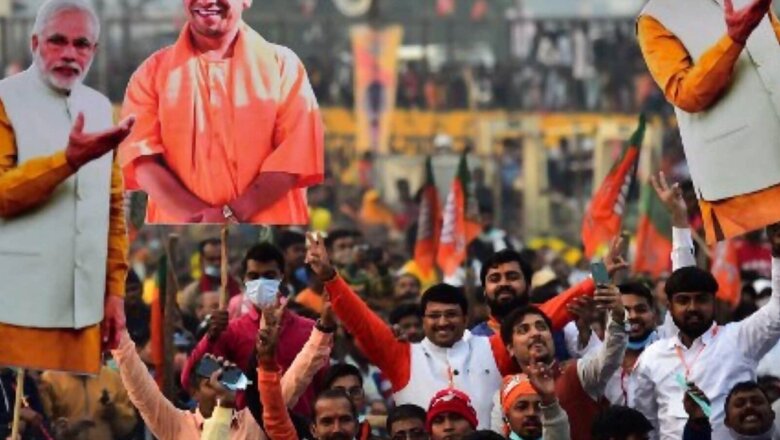How Threads of Backroom Planning, AIMIM Vote-split & Kairana Push Spun Saffron Yarn of Modi-Yogi Win

views
The Bharatiya Janata Party’s script to success in Uttar Pradesh is historic, but not completely simple. There are a myriad of factors and the BJP’s own efforts that helped the saffron party get reelected in the politically-important northern state. A split in anti-BJP votes, a push for narratives against the Samajwadi Party solidified through repeated campaigning and meticulous backdoor planning helped spin the saffron yarn of success.
One of the seats won by the saffron party, Darul Ulum’s hometown is Deoband, for a second term was a hot topic of debate among pollsters. The BJP has won Deoband, one of India’s most influential Islamic seminaries, for the second time in a row. The town is located in the Saharanpur district and has a 70 percent Muslim population, but the constituency only has 40 percent Muslim voters. Brijesh Singh of the Bharatiya Janata Party defeated Kartikeya Rana of the Samajwadi Party by 7,104 votes.
According to reports, All India Majlis-e-Ittehad Muslimeen (AIMIM) party candidate Umair Madani in Deoband received 3,500 votes. The margin of victory between the BJP and SP candidates was just over 7,000 votes. If the AIMIM had not fielded a candidate, those three thousand odd votes could have aided the SP candidate’s victory. The AIMIM did not run a candidate for this seat in the 2017 elections.
The saffron party may also have benefited from the split in anti-BJP votes in a possible re-run of the 2017 results. The Bahujan Samaj Party’s Chaudhary Rajendra Singh and the Congress’ Rahat Khalil polled over 53,000 votes together, which could have benefited SP candidate Rana.
In 2017, the BJP’s Brijesh Singh received 1.02 lakh votes, benefiting from a vote split caused by Muslim candidates fielded by both the SP and the BSP. Majid Ali of the Bahujan Samaj Party received 72,844 votes, while Maviya Ali of the SP received 55,385 votes.
However, in a Muslim-majority seat, a non-Muslim BSP candidate receiving over 52,000 votes suggests that votes were not cast on religious lines. If this were the case, the Congress candidate would have won.
Meanwhile, in seats such as Lakhimpur Kheri and Hathras, BJP’s planning was so meticulous that the BJP won all eight seats in Lakhimpur, despite the fact that the district had become a hotbed of opposition protests following the October 3 incident in which farmers were run over by a vehicle.
According to political experts, despite the opposition’s efforts to focus on the Lakhimpur Kheri and Hathras incidents in order to weave a narrative against the BJP, the public supported the new “M-Y” factor in UP politics. The “M-Y” factor now refers to the “Modi-Yogi” combination rather than the Samajwadi Party’s “Muslim-Yadav” combination. There were also casualties, with the government of Yogi Adityanath losing ten ministers. Despite setbacks, the BJP ensured that anti-incumbency did not have a significant impact on it.
Both Prime Minister Narendra Modi and Chief Minister Yogi Adityanath acknowledged the role of “naari shakti (women voters)” in these elections, and party leaders agreed that 29 of the 48 women contestants who won on a BJP ticket are proof.
Allies were also an important part of the BJP’s strategy. After extensive deliberation, tickets were distributed to pre-poll allies. The party finalised ticket distribution and seat-sharing after several rounds of discussions with the top leadership. Fifteen Nishad party candidates ran in the elections, five of whom used the BJP symbol. Six Nishad party candidates were elected on their own symbols in coalition with the BJP. All five other candidates running under the BJP symbol were also victorious.
Meanwhile, when SP chief Akhilesh Yadav sparked a raging controversy by comparing Muslim League leader and Pakistan founder Mohammad Ali Jinnah to India’s first home minister Sardar Vallabhbhai Patel on October 31, last year, the BJP got the ammunition it was presumably waiting for.
Soon, Akhilesh was facing salvos in what was the BJP’s first and most convincing attempt to pit SP against the Muslim community ahead of the UP elections. The BJP maintained the narrative by recalling the Kairana exodus issue, which had played a critical role in the BJP’s electoral success, particularly in politically restive west UP during the 2017 assembly elections.
Even as Yogi Adityanath initiated the process by visiting Kairana in November, home minister Amit Shah heightened the issue by launching the BJP’s election campaign in the town’s alleyways in Shamli district. The SP’s decision to field Nahid Hasan, who is currently incarcerated in connection with several cases, from Kairana allowed the BJP to further shape the narrative. In June 2016, then-BJP MP Hukum Singh released a list of 346 people forced to flee Kairana, a Muslim-majority town in Uttar Pradesh, due to “threats and extortion by criminals.”
Read all the Latest Politics News and Breaking News here




















Comments
0 comment